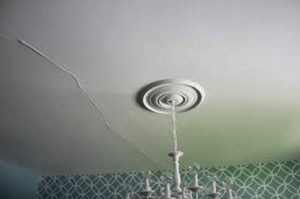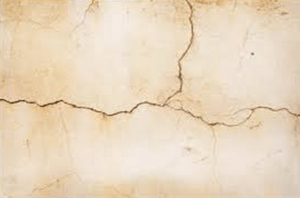Lots of houses have cracks. We can find them in the ceiling, on the walls and sometimes in concrete floors as well. So why do cracks appear? How do they happen, and is there a way to fix them?
Having a crack in your home can be an alarming sight, but there’s always a reason for these problems to occur, and it helps to know why.
The crack you pass everyday in your house may be one of these two things: Harmless, or Expensive!
Firstly, consider moisture. Some ceilings may be exposed to large amounts of moisture, usually coming from a direct source, such as a bathroom on the second floor. This usually indicates some issues with plumbing. Leaks in the pipes connected to sink basins, bathtubs or the shower. If you are located in an area that is prone to storms, high levels of rain and strong winds, it could also be possible that your roof has suffered some damage, allowing rain water in.
Here we can see a large crack on a ceiling. This is a result of water damage.
Both aspects of water and temperature fluctuation can cause a ceiling to crack. As materials absorb water and gain heat, your ceiling may expand, pushing outwards. If it then cools down and dries up, it will shrink, causing the material to split apart.
While this may look pretty bad and like it’s going to cost you hard earned dollars, you can rest assured that in almost any case, a crack in this situation is merely a symptom, and not a problem. It will cause no further damage to your house, and only requires some basic maintenance attention.
However, you should also consider the structure of your house. This is much more serious than simple weather or water damage, as you could be dealing with a much bigger problem, and putting you and your family at risk. Sometimes when your house is being built, some calculations made, could be wrong. In one such case, the engineer didn’t accurately calculate the weight of the second story of the house, causing it to shift slightly and exposing cracks.
This is also very common with houses that are on slopes, or built on soft foundations.
Sometimes the earth that the foundation is built on can sink or shift, allowing the house to move with it. This doesn’t just apply to double story homes. The weight of the roof itself can cause the walls to shift in their place. Have you ever tried building a house of cards? Similar concept; if the weight of the cards isn’t distributed properly, the walls will move. Only in this case, you’ll notice cracks before the whole thing collapses, so that’s a plus.
This is a crack in a concrete wall as a result of a foundation issue
Unlike a water or temperature damage crack, structural cracks can be found more commonly in materials much more solid, like concrete and brick. Noticing a large crack in any strong material is usually a bad sign, and would require some fast attention.
So what can you do to fix a crack?
Well, if you have a crack in your ceiling as a result of high levels of moisture, the answer is pretty obvious. Correct where the source of moisture is coming from and then patch up the cracks, to avoid any eye sores or possible depreciation in value. Most ceilings are made up of drywall or similar materials, so plaster would get the job done.
If the cracks appearing around your house are caused by a structural issue, then you may have to go deeper. In some cases these cannot be fixed, or you would be forced to go to great lengths to rectify it. For example, if the problem is in the foundation, one may find it difficult to lift up the house and make some alterations. However some problems stem from loose joints in the roof’s structure, which are much easier to adjust and strengthen.
If your house is on stilts you may be able to go under the house and properly identify the issue.
Because the crack itself is only a symptom and not the problem, in most cases it is fine to be left alone when the issue has been rectified. A professional building inspection will provide a summary of any cracks present, and determine whether it is something that will require further attention.







